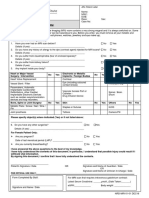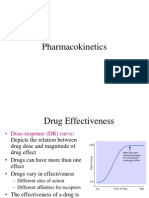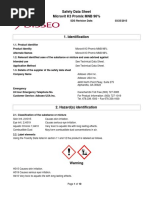Lab4 MultipleLinearRegression
Uploaded by
Jason ThiamLab4 MultipleLinearRegression
Uploaded by
Jason ThiamEM0442 Lab 4
Singapore Polytechnic
EM0442- Artificial Intelligence and Data Analytics for Aerospace
Lab 4: Multiple Linear Regression
1 Learning Objectives
When you have completed this lab, you should be able to:
1. Understand how to perform multiple linear regression (MLR) using least squares
2. Understand how to display the results of MLR.
3. Apply the method of p-values to if independent variables included in the
regression are significant.
4. Examine the correlation matrix for our data.
2 Multiple Linear Regression
Multiple Linear Regression (MLR) is the process of trying to find the best plane or hyperplane to fit
a set of data pairs. The complete listing of the Python script to do this can be found in the Appendix.
We will look at the four main sections of this program once again as we will want to modify it later.
2.1 Data input and preparation
Temp = [14.2,16.4,11.9,15.2,18.5,22.1,19.4,25.1,23.4,18.1,22.6,17.2]
Temp = np.array(Temp)
Income = [2680,4030,2170,4030,4900,6270,4850,7270,6500,4940,5460,5100]
Income = np.array(Income)
Sales = [215,325,185,332,406,522,412,614,544,421,445,408]
Sales = np.array(Sales)
Here we see the Temperature data being entered as a list as well as the Sales vector and now we
have an Income vector all of which need to be converted to numpy ndarrays.
If needed, a scatterplot can be drawn at this point. But for our lab it is not shown till the end of the
program.
2.2 Computation
In a similar fashion to our Simple Linear Regression example, we use a least squares method to
obtain a solution to the line of best fit that explains the data given. As before, we create a matrix
that contains the independent variable. The leftmost column of this matrix has to be a series of ones
and this time we stack on two sets of variables. This can be repeated for more variables.
Singapore Polytechnic, School of EEE v1.1 Page 1
EM0442 Lab 4
def MLRegress(Temp,Income,Sales):
Z = np.ones(Temp.shape) # join two vectors
Z = np.vstack((Z, Temp)) # by vertical stacking
Z = np.vstack((Z, Income)) # by vertical stacking
Z = Z.T # array of numberdatapoints x # variables
b,resid,rank,sgl = np.linalg.lstsq(Z,Sales,rcond=None)
return b
This time, the b vector is returned such that b[2] * x2 b[1] * x1 + b[0] will be the three dimensional
(3D) plane line that gives the best fit in the LSE sense to the data vector x.
Also note that can we only visualize the results for two independent variables and one
dependent variable in 3D space.
2.3 Post processing
In order to show some meaningful data, we need to plot the predicted values obtained by the least
squares procedure in a 2D representation of a 3D plot – as isometric sort of view.
3D surface (plane)
In this case, we cannot just have two 1D sets of data and expect it to be plotted for us. We are
plotting a surface and the coordinates of all the points on that surface needs to be generated.
1_ The values of all x and y coordinates need to be generated first using the arange() function.
These values are purely for plotting, so they need not be in the original set of data. These data
vectors are xmesh and ymesh.
2_ These vectors are passed to the meshgrid function which now generates a grid of data.
In other words, the xmesh(Temp) vector is now duplicated by the number of elements in
the ymesh(Income) vector. And similarly for the other way round.
3_ Now all the z axis data needs to be generated in zmesh, in this case by the line:
Singapore Polytechnic, School of EEE v1.1 Page 2
EM0442 Lab 4
zmesh = (b[0] + b[1]*xmesh + b[2]*ymesh)
So that zmesh contains the predicted Sales values, so that a surface can be plotted.
# Prepare the 3D plot
xmesh = np.arange(min(Temp),max(Temp)) # generate range of values
ymesh = np.arange(min(Income),max(Income),100)
xmesh, ymesh = np.meshgrid(xmesh, ymesh)
zmesh = (b[0] + b[1]*xmesh + b[2]*ymesh) # compute z values
2.4 Display output
The facilities to do all the simulated 3D printing is from the mpl_toolkits.mplot3d
library from which we import the Axes3D module. This module has its own plot command. In the
upper part of the figure, we construct a special 3D scatter plot which shows if predicted data
points are above or below the plane.
from mpl_toolkits.mplot3d import Axes3D
. . .
ax.plot([xs[i], xs[i]], [ys[i], ys[i]], [0, zs[i]], ':', linewidth=2, color=colr, alpha=.5)
# plot up arrow for Sales above actual else down arrow
ax.plot([xs[i]], [ys[i]], [zs[i]], markertype, markersize=8,
markerfacecolor='none', color= colr,label='ib')
. . .
ax.plot_surface(xmesh, ymesh, zmesh, alpha=0.2) # plot it
This is done by comparing the computed (zsb = b[0] + b[1]*xs[i] + b[2]*ys[i]) with the actual
value (zs[i]) as shown below.
xs = Temp; ys = Income; zs = Sales
for i in range(len(xs)):
# check if computed z is < actual value
zsb = b[0] + b[1]*xs[i] + b[2]*ys[i]
# use differing colours to indicate if actual z value is above computed
if zsb < zs[i]:
markertype = '^'; colr = 'b' # computed is below
else:
markertype = 'v'; colr = 'g'
2.5 Try it out!
Copy the code and run it and view the results. You may wish to modify the outputs and add in
various kinds of annotations. Save the program and get ready for a modification.
Singapore Polytechnic, School of EEE v1.1 Page 3
EM0442 Lab 4
3 Backward elimination
We will now use the p-value to identify the significant independent variables. We will use the
statsmodels.api library and use only a few of its functions.
3.1 Bringing in a statistics library – try it out!
Modify the previous program by importing the library. You may either modify or copy the code in
the MLRegress function to another function MLRegressOLS to easily compare results. Add in the lines
in BOLD which will give you the summary statistics. Also, add: from statsmodels.api
import sm.
b,resid,rank,sgl = np.linalg.lstsq(Z,Sales,rcond=None)
est = sm.OLS(Sales, Z)
est2 = est.fit()
print(est2.summary())
return b
Run the program again and look at the output of the OLS function.
Parameters p-values for x1,x2 Actual variable name
x1
x2
R-squared
Which variable is not considered significant?
4 Looking at the correlation matrix
In the final part of this lab, we will examine the correlation matrix for our dataset. It is placed
here to emphasise that this matrix should be a final tool to gain insights into the multiple
linear analysis. Note the following:
1. The use of the corrcoef module from numpy to compute the correlation matrix.
2. Displaying the matrix is done using the imshow function from matplotlib. Essentially the
matrix is treated as an image – in this case the size is 3 x 3 pixels.
The colorbar shows the colour associated with the values in the image.
Compare your result with that in the lecture slides. Note that the correlation coefficients are all
above 0.95 and yet one of the independent variables are not useful.
5 Trying your own dataset
A delivery company trying to predict the travel time for his drivers. To conduct an analysis 10
random samples are collected from past trips are listed below.
Miles Travelled Num of Deliveries Gas Price Travel Time
89 4 3.84 7
66 1 3.19 5.4
78 3 3.78 6.6
111 6 3.89 7.4
Singapore Polytechnic, School of EEE v1.1 Page 4
EM0442 Lab 4
44 1 3.57 4.8
77 3 3.57 6.4
80 3 3.03 7
66 2 3.51 5.6
109 5 3.54 7.3
76 3 3.25 6.4
i) Check the correlation between dependent and each independent variable independently.
ii) Investigate independent variables, is there a collinearity?
iii) Drop the variable with weak correlation and conduct MLR analysis. What is your
conclusions?
Singapore Polytechnic, School of EEE v1.1 Page 5
EM0442 Lab 4
APPENDIX – Program Listing – functions – 1 / 3 (append to 2 / 3)
# Multiple Linear Regression
import numpy as np
import matplotlib.pyplot as plt
from mpl_toolkits.mplot3d import Axes3D
import pdb
def MLRegress(Temp,Income,Sales):
Z = np.ones(Temp.shape) # join two vectors
Z = np.vstack((Z, Temp)) # by vertical stacking
Z = np.vstack((Z, Income)) # by vertical stacking
Z = Z.T # array of numberdatapoints x # variables
b,resid,rank,sgl = np.linalg.lstsq(Z,Sales,rcond=None)
return b
def plot3Dstem(Temp,Income,Sales,b,ax):
# for a 3D plot of a plane, we want to see sample data points that are
# above or below the plane, in the z (vertical) axis
xs = Temp; ys = Income; zs = Sales
for i in range(len(xs)):
# check if computed z is < actual value
zsb = b[0] + b[1]*xs[i] + b[2]*ys[i]
# use differing colours to indicate if actual z value is above computed
if zsb < zs[i]:
markertype = '^'; colr = 'b' # computed is below
else:
markertype = 'v'; colr = 'g'
# special 3D stem plot
ax.plot([xs[i], xs[i]], [ys[i], ys[i]], [0, zs[i]], ':', linewidth=2, color=colr, alpha=.5)
# plot up arrow for Sales above actual else down arrow
ax.plot([xs[i]], [ys[i]], [zs[i]], markertype, markersize=8,
markerfacecolor='none', color= colr,label='ib')
return # nothing to return!
Singapore Polytechnic, School of EEE v1.1 Page 6
EM0442 Lab 4
APPENDIX – Program Listing – functions – 2/3
# Main program
Temp = [14.2,16.4,11.9,15.2,18.5,22.1,19.4,25.1,23.4,18.1,22.6,17.2]
Temp = np.array(Temp)
Sales = [215,325,185,332,406,522,412,614,544,421,445,408]
Sales = np.array(Sales)
Income = [2680,4030,2170,4030,4900,6270,4850,7270,6500,4940,5460,5100]
Income = np.array(Income)
# compute
b = MLRegress(Temp,Income,Sales)
# prepare output - set the basic plot first
fig = plt.figure(figsize=(8,6), dpi=100) # 800 x 600 pixels
ax = fig.add_subplot(111, projection='3d') # recommended approach
plt.title('Ice-cream sales vs Temperature and Income');
ax.set_xlabel('Temperature (deg C)')
ax.set_ylabel('Income $')
ax.set_zlabel('Sales $')
# plot the stems
plot3Dstem(Temp,Income,Sales,b,ax)
# Plot the plane
# Prepare the 3D plot
xmesh = np.arange(min(Temp),max(Temp)) # generate range of values
ymesh = np.arange(min(Income),max(Income),100)
xmesh, ymesh = np.meshgrid(xmesh, ymesh)
zmesh = (b[0] + b[1]*xmesh + b[2]*ymesh) # compute z values
ax.plot_surface(xmesh, ymesh, zmesh, alpha=0.2) # plot it
plt.savefig('MLR.svg')
plt.show()
APPENDIX – Program Listing – Correlation plot – 3/3
# correlation coeff
xyz = np.vstack((Temp,Income,Sales)) # vertical stack #variables X #samples
corrcoef = np.corrcoef(xyz)
fig, ax = plt.subplots()
im=ax.imshow(corrcoef, cmap='coolwarm')
ax.figure.colorbar(im)
ax.xaxis.set(ticks=(0, 1, 2), ticklabels=('Temp', 'Income', 'Sales'))
ax.yaxis.set(ticks=(0, 1, 2), ticklabels=('Temp', 'Income', 'Sales'))
ax.set_title('Correlation coefficients')
ax.set_ylim(2.5, -0.5) # make sure the coloured squares fit into the boundary need to try!
for i in range(3):
for j in range(3):
ax.text(j, i, (int(corrcoef[i, j]*100))/100, ha='center', va='center', color='y')
plt.savefig('CorrCoef.svg')
plt.show()
Singapore Polytechnic, School of EEE v1.1 Page 7
You might also like
- MUNAR - Linear Regression - Ipynb - ColaboratoryNo ratings yetMUNAR - Linear Regression - Ipynb - Colaboratory30 pages
- C1 W1 Lab03 Model Representation Soln-Copy1No ratings yetC1 W1 Lab03 Model Representation Soln-Copy17 pages
- Cap8 Predicting Continuous Target Variables with Regression Analysis - Thakur Ankita 2016 - Python Real World Data ScienceNo ratings yetCap8 Predicting Continuous Target Variables with Regression Analysis - Thakur Ankita 2016 - Python Real World Data Science36 pages
- A Brief Introduction to MATLAB: Taken From the Book "MATLAB for Beginners: A Gentle Approach"From EverandA Brief Introduction to MATLAB: Taken From the Book "MATLAB for Beginners: A Gentle Approach"2.5/5 (2)
- L. D. College of Engineering: Lab Manual ForNo ratings yetL. D. College of Engineering: Lab Manual For70 pages
- Estimate Support and Resistance of A Stock With PythonNo ratings yetEstimate Support and Resistance of A Stock With Python18 pages
- Vertopal.com C1 W2 Lab02 Multiple Variable SolnNo ratings yetVertopal.com C1 W2 Lab02 Multiple Variable Soln11 pages
- 4.1.2.4 Lab - Simple Linear Regression in PythonNo ratings yet4.1.2.4 Lab - Simple Linear Regression in Python6 pages
- Experiment Number: 3: Aim:-Study of The Linear Regression in The Machine Learning Using The Boston Housing Dataset. 1)No ratings yetExperiment Number: 3: Aim:-Study of The Linear Regression in The Machine Learning Using The Boston Housing Dataset. 1)14 pages
- An Introduction to Stadistical Learning-129-140-1-8No ratings yetAn Introduction to Stadistical Learning-129-140-1-88 pages
- Simple Linear Regression With Jupyter Notebook: Dr. Alvin AngNo ratings yetSimple Linear Regression With Jupyter Notebook: Dr. Alvin Ang16 pages
- Lecture-17-Linear Regression Using SklearnNo ratings yetLecture-17-Linear Regression Using Sklearn32 pages
- Tutorial 1 Not Sad But Not Happy (Student) - AY2324S1No ratings yetTutorial 1 Not Sad But Not Happy (Student) - AY2324S15 pages
- Tutorial 0 Introduction Tutorial (Student) - AY2324S11No ratings yetTutorial 0 Introduction Tutorial (Student) - AY2324S115 pages
- Contax N/645 - Sony E Full Auto Adapter Ring Mk3 User's Manual (V. 31)No ratings yetContax N/645 - Sony E Full Auto Adapter Ring Mk3 User's Manual (V. 31)5 pages
- Format No. 16 List of Paper Setter - DCMOSNo ratings yetFormat No. 16 List of Paper Setter - DCMOS2 pages
- MRI Safety Screening Form - Amended - 30NOV2016No ratings yetMRI Safety Screening Form - Amended - 30NOV20161 page
- Tunnel Fire Protection: A Lost Formwork System, Using PROMATECT - HNo ratings yetTunnel Fire Protection: A Lost Formwork System, Using PROMATECT - H24 pages
- A Comparative Review On Power Conversion Topologies and Energy Storage EV - IMPORTANT - CLASSIFICATION OF EVS - HEVSNo ratings yetA Comparative Review On Power Conversion Topologies and Energy Storage EV - IMPORTANT - CLASSIFICATION OF EVS - HEVS24 pages
- Coefficients For Cement Consumption in QuintalNo ratings yetCoefficients For Cement Consumption in Quintal14 pages
- ADI-145 Microvit K3 Promix MNB 96 (en-US)No ratings yetADI-145 Microvit K3 Promix MNB 96 (en-US)10 pages
- Eckhart Tolle and The Fallacies of Borrowed BuddhismNo ratings yetEckhart Tolle and The Fallacies of Borrowed Buddhism3 pages
- 5E - Lost Lands - The Blight - TB1 The Crooked Nail (LVL 1)100% (4)5E - Lost Lands - The Blight - TB1 The Crooked Nail (LVL 1)39 pages
- 5 - Foundation Knowledge of Forensic Odontology Lec 1No ratings yet5 - Foundation Knowledge of Forensic Odontology Lec 115 pages
- A Friendly Introduction to MATLAB ProgrammingFrom EverandA Friendly Introduction to MATLAB Programming
- Cap8 Predicting Continuous Target Variables with Regression Analysis - Thakur Ankita 2016 - Python Real World Data ScienceCap8 Predicting Continuous Target Variables with Regression Analysis - Thakur Ankita 2016 - Python Real World Data Science
- A Brief Introduction to MATLAB: Taken From the Book "MATLAB for Beginners: A Gentle Approach"From EverandA Brief Introduction to MATLAB: Taken From the Book "MATLAB for Beginners: A Gentle Approach"
- Estimate Support and Resistance of A Stock With PythonEstimate Support and Resistance of A Stock With Python
- Experiment Number: 3: Aim:-Study of The Linear Regression in The Machine Learning Using The Boston Housing Dataset. 1)Experiment Number: 3: Aim:-Study of The Linear Regression in The Machine Learning Using The Boston Housing Dataset. 1)
- An Introduction to Stadistical Learning-129-140-1-8An Introduction to Stadistical Learning-129-140-1-8
- Simple Linear Regression With Jupyter Notebook: Dr. Alvin AngSimple Linear Regression With Jupyter Notebook: Dr. Alvin Ang
- MATLAB for Beginners: A Gentle Approach - Revised EditionFrom EverandMATLAB for Beginners: A Gentle Approach - Revised Edition
- Top Numerical Methods With Matlab For Beginners!From EverandTop Numerical Methods With Matlab For Beginners!
- Tutorial 1 Not Sad But Not Happy (Student) - AY2324S1Tutorial 1 Not Sad But Not Happy (Student) - AY2324S1
- Tutorial 0 Introduction Tutorial (Student) - AY2324S11Tutorial 0 Introduction Tutorial (Student) - AY2324S11
- Contax N/645 - Sony E Full Auto Adapter Ring Mk3 User's Manual (V. 31)Contax N/645 - Sony E Full Auto Adapter Ring Mk3 User's Manual (V. 31)
- Tunnel Fire Protection: A Lost Formwork System, Using PROMATECT - HTunnel Fire Protection: A Lost Formwork System, Using PROMATECT - H
- A Comparative Review On Power Conversion Topologies and Energy Storage EV - IMPORTANT - CLASSIFICATION OF EVS - HEVSA Comparative Review On Power Conversion Topologies and Energy Storage EV - IMPORTANT - CLASSIFICATION OF EVS - HEVS
- Eckhart Tolle and The Fallacies of Borrowed BuddhismEckhart Tolle and The Fallacies of Borrowed Buddhism
- 5E - Lost Lands - The Blight - TB1 The Crooked Nail (LVL 1)5E - Lost Lands - The Blight - TB1 The Crooked Nail (LVL 1)
- 5 - Foundation Knowledge of Forensic Odontology Lec 15 - Foundation Knowledge of Forensic Odontology Lec 1





























































































